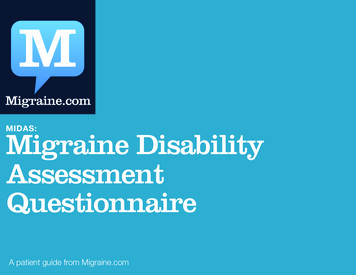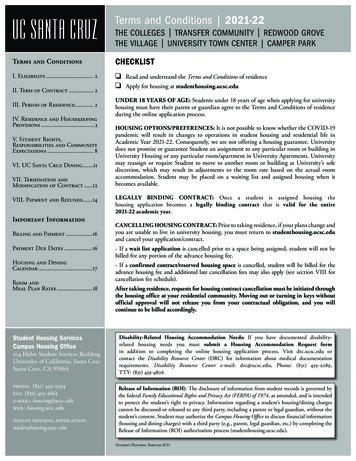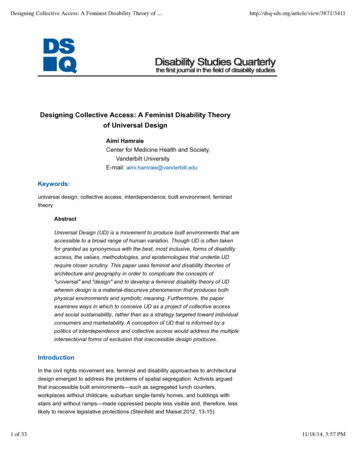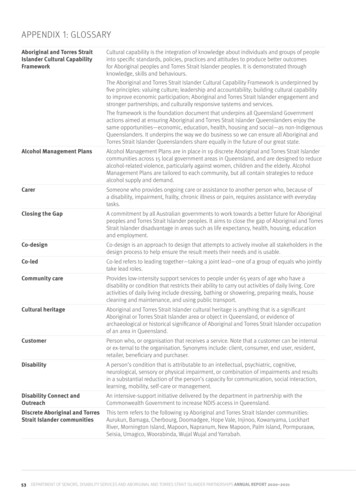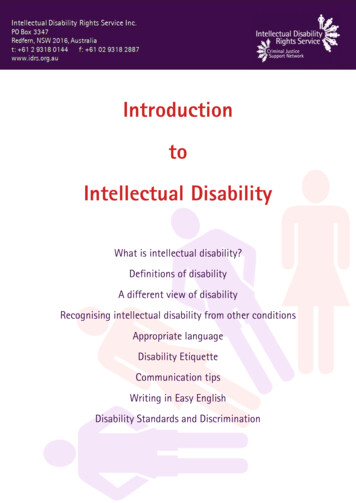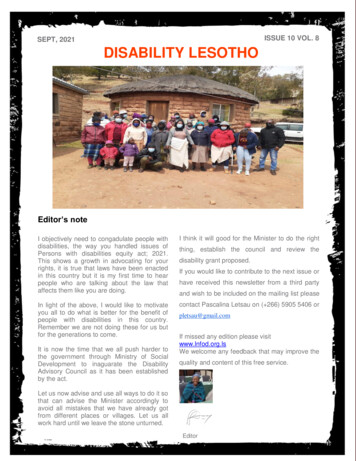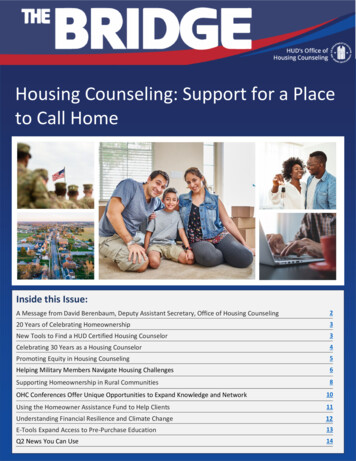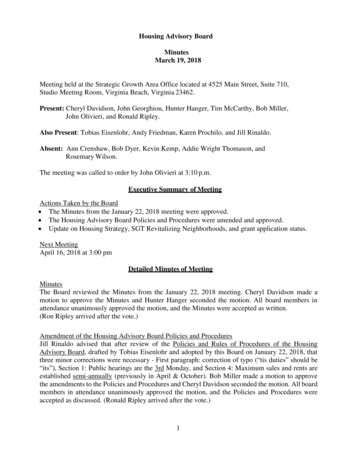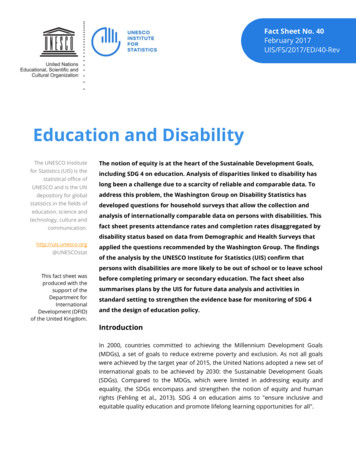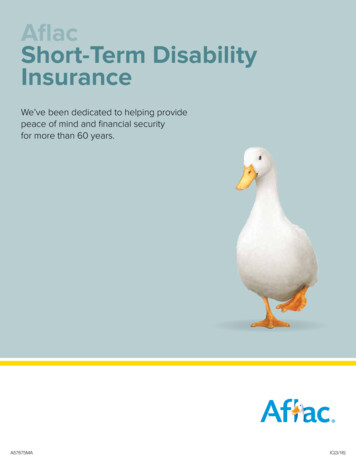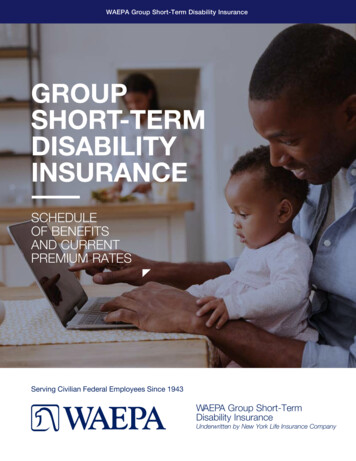
Transcription
The Harvard Joint Center forHousing Studies advancesunderstanding of housingissues and informs policythrough research, education,and public outreach.Working Paper, April 2016Disability Housing:What’s happening? What’schallenging? What’s needed?Micaela Connery2015 Research Fellow, JCHSM.P.P. 2016, Harvard Kennedy SchoolAbstractFor adults with intellectual or developmental disabilities, asuitable home is sometimes almost impossible to come by.Hundreds of thousands of adults with disabilities across theU.S. sit on housing “wait lists” for home and community-basedservices. Even if they’re ready to make the move out of theirparents’ home into community or independent living, the housing options and funding supports often don’t exist.living in the community.” The challenge isn’t new, but rootedin a history of disability services that has evolved from a focuson Care (a Kennedy-driven era of special services), to Choice(a self-advocated Independent Living shift to emphasize selfdetermination and respect, to Access (an ADA focus on equalaccess and opportunity). An ongoing tension between Care,Choice, and Access remains today.Growing populations, decreased funding, and a diversity ofstrategies is a challenge for federal and state policy leadersas well as for on-the-ground service providers. Research onwhat makes a “quality” housing option is often conflicted. Bestpractices in housing design and service delivery have not beensufficiently explored, defined, or shared.Case studies profile four providers with differing approachesto housing and service delivery, and how they face commonchallenges in staffing, meeting regulatory requirement, andserving a population with diverse needs. Providers and regulators constantly work to find the right balance between integration and independence, risk and autonomy.This paper explores the issues facing individuals, families,providers, and policy leaders across the country. Individualswith disabilities and advocates have been fighting for thoughtful supports, inclusion in communities, and independentliving since the 1960s “based on the premise that people witheven the most severe disabilities should have the choice ofThis paper concludes with recommendations for organizations and policymakers in order to support the best possiblehousing choices for the millions of Americans with disabilities, where solutions and services represent a thoughtfulbalance between Care, Choice, and Access, and should avoid“one-size fits-all” design. 2016 President and Fellows of Harvard CollegeAny opinions expressed in this paper are those of the author(s) and not those of the Joint Center for Housing Studies ofHarvard University or of any of the persons or organizations providing support to the Joint Center for Housing Studies.For more information on the Joint Center for Housing Studies, see our website at http://jchs.harvard.eduJOINT CENTER FOR HOUSING STUDIES OF HARVARD UNIVERSITY
Disability Housing:What’s happening? What’s challenging? What’s needed?Micaela Connery April 2016
Disability Housing: What’s happening? What’s challenging? What’s needed?Table of ContentsIntroduction . 1What’s Happening . 3Policy Approaches . 3Legislation and Litigation . 4Funding Sources . 6Housing and Support Service Types . 9Thinking Forward . 11Case Studies . 12Case Study: Southbury Training School . 12About Southbury Training School . 12Key Themes From Southbury: . 14Case Study: Sweetwater Spectrum . 16About Sweetwater. 16Key Themes From Sweetwater. 17Case Study: L’Arche International . 18About L’Arche . 18Key Themes From L’Arche . 21Case Study: Looking Upwards . 22About Looking Upwards . 22Key Themes From Looking Upwards . 24What’s Challenging . 26Understanding the Impact of Size . 26Recruiting and Retaining Staff . 27Burdensome Policies and Regulations . 27Linking Housing, Employment, and Transportation . 28Meeting a Diverse Set of Needs .29Realizing Independence Varies .30Supporting the Right to Risk .30What’s Needed . 31Engaging Parents and Families .31Staffing .31Supporting Choice. 31Making Space for Innovation.32Policy and Strategy Considerations . 32Linking Disability and Other Housing Needs. 32Engaging Millennials . 32Making Direct Service a Professional Career . 33Serving Aging Individuals with Disabilities . 34Further Research Required. 34Conclusion. 35Appendices . 36Acronyms.36Relevant Legislation.37Acknowledgements .38About the Author.38Micaela Connery
Disability Housing: What’s happening? What’s challenging? What’s needed?IntroductionWhen you stop and think about it, our homes,including the people who share them with us,defines a lot about our lives. A home is thephysical space where we greet each day. Thepeople we share it with are fixtures in andinfluences on our lives. It's where we welcomeguests, cozy up when we're sick, and retreat at theend of a long week.But for many adults with intellectual ordevelopmental disabilities, a suitable home ishard – sometimes almost impossible – to come by.Hundreds of thousands of adults with disabilitiesacross the U.S. sit on housing “wait lists” for homeand community-based services. 1 Even if they’reready to make the move out of their parents’home into community or independent living, thehousing options and funding supports often don’texist. Some don’t even receive the adequateservices they need within their family home. Astheir needs change due to age and circumstance,some wait on corresponding changes to theirservices or type of residence.For someone with a disability, the 22nd birthdayis often bittersweet. While education ofindividuals with disabilities is guaranteedthrough mandates like the Individuals withDisabilities Education Act, support and services,including housing, are not guaranteed inadulthood. Once individuals with disabilities turn21, they exit the public education system andenter the challenging and underfunded world ofadult services. The support they receive dependson funds available, their determined level of need,and the programs and services in their region.Even families who start planning for thistransition long before the 21st year findthemselves without placement options on thatbittersweet birthday.The Arc. 'The Arc, Medicaid Issues.' N.p. 2015. Web. 15July 2015.1Micaela ConneryI’ve met parent after parent struggling with thisissue of housing and transition to adulthood.Parents of a preschooler with Down syndrome isalready planning and determining how muchmoney they should (and can) save to fundtransition. Parents of a teenager with autism whothink their son might be able to liveindependently with some supports are trying tofigure out what kind of housing will be right forhim and whether it exists near their hometown. Asingle mother tries to wrap her head around thecomplexities of adult services and housing,knowing she does not have the resources to fundher child’s needs. An aging parent of an olderadult with multiple disabilities still has his childliving at home; they have been on a “wait list” forservices and housing for over fifteen years. Allthese parents, like hundreds of thousands acrossthe country, ask the same worrisome question:Where will my child live and who will support themafter I die?Increased funding is an important but only partialsolution. Beyond the political challenges ofsecuring increased funding, funding increases areconstantly playing catch up with increasingnumbers of people with disabilities needingsupport. In 2014 my home state of Connecticut,parents, advocacy organizations, and thedisability caucus fought hard for 4 million for theDepartment of Developmental Services (DDS) tosupport housing. Although an important step, that 4 million placed only 100 people off the wait listof almost 4,000 at the time. 2 Funding alone won'tlikely fix the problem.As the population of individuals with disabilitieshas grown and institutions for them have closed,advocates have responded by rallying parentsupport and launching new organizations; theyhave experimented with new policies,operational structures, and funding sources(especially from the private sector). StrategiesConnecticut Senate Democrats. 'Press Release FromSenator Beth Bye.' N.p. 2015. Web. 18 June 2015.2April 20161
Disability Housing: What’s happening? What’s challenging? What’s needed?for housing people with disabilities havediversified to respond to diverse needs.Growing populations, decreased funding, and adiversity of strategies is a challenge for federaland state policy leaders as well as for on-theground service providers. Research on whatmakes a “quality” housing option is oftenconflicted. Strict regulations are clear about whatis not allowed but fall short in defining what isencouraged. Best practices and key challenges inhousing design and service delivery have notbeen sufficiently explored, defined, or shared. Wegenerally understand what we want to removeand avoid in disability housing and services, butwe lack a consensus about what we want to addor create.With support from the Joint Center for HousingStudies at Harvard University and the Center forPublic Leadership at the Harvard Kennedy School,this paper explores some of the issues facingindividuals, families, providers, and policyleaders across the country. Using case studies offour very different housing providers, this paperexplores current structures and offerings forhousing for people with disabilities, whatchallenges create the biggest barriers forindividuals and providers, and how policymakerscan support the best possible housing choices forthe millions of Americans with disabilities.This paper focuses intentionally on the broaderpicture of disability housing, and aims to: Explore best practices and key challengesacross different disability housing serviceproviders and models.Outline universal policy challenges andareas where policy can better support bestpractices in disability housing.Provide a usable white-paper for thosedeveloping new housing for people withUC Berkeley. 'The Disability Rights And IndependentLiving Movement - University Of California, Berkeley.' N.p.2015. Web. 9 May 2015. disabilities, as well as for policymakers,agency directors, and service providers, onwhat we should be doing, as well as whatwe shouldn’t.Identify areas where future research andassessment are needed.Individuals with disabilities and their advocateshave been fighting for thoughtful supports,inclusion in communities, and independent livingsince the 1960s "based on the premise that peoplewith even the most severe disabilities shouldhave the choice of living in the community." 3 Thechallenge isn't new, but the regulatory approachand structural solutions will need to be.Terminology: “Persons with Disabilities”In this paper, the term “persons with disabilities”refers to people with intellectual ordevelopmental disabilities or with autism. Theterm may refer to and include people withintellectual or developmental disabilities orautism who also have mental illness, physicaldisabilities, vision or hearing impairments, ormedical needs. However, the reader should beaware that in this paper “persons withdisabilities” does not refer to individuals whohave only mental illness, physical disabilities,vision or hearing impairments, or medical needs.Acronyms are defined when they first occur andalso listed in detail in Appendix AAny opinions expressed in this paper are solely those ofthe author and not those of the Joint Center for HousingStudies of Harvard University, the Center for PublicLeadership at the Harvard Kennedy School, theproviders or individuals referenced, or organizationswho provide support to the aforementioned entities.The findings and conclusion of this report are solely theresponsibility of the author.3Micaela ConneryApril 20162
Disability Housing: What’s happening? What’s challenging? What’s needed?What’s HappeningPolicy ApproachesMany disability advocacy organizations attributethe start of a proactive national disability policyto John F. Kennedy’s presidency and his family’scontinued focus on issues relating to disabilitybecause of their sister Rosemary. Even beforeKennedy entered the White House, the family hadlaunched the Joseph P. Kennedy Foundationaiming to "seek the prevention of intellectualdisabilities by identifying its causes, and toimprove the means by which society deals withcitizens who have intellectual disabilities.” 4Kennedy’s time in office brought about thefounding of the President's Panel on MentalRetardation, numerous public and congressionalstatements about the importance of supportingand caring for those with disabilities (particularlychildren), more scientific research intoprevention and services, and the start of anational movement away from institutions ntered agencies.” 5 This process ofdeinstitutionalization continues today. In manyways, the Kennedy administration laid thefoundation for subsequent legislation and courtdecisions (outlined in the following section).Of course, disability policy has not always beendriven by the White House. With more and moreindividuals with disabilities living independentlyoutside of institutions, a movement of selfadvocacy began to take hold in the mid-1960s.People with disabilities pushed for more peerdetermined and self-determined decision-makingThe John F. Kennedy Presidential Library & Museum. 'JFKAnd People With Intellectual Disabilities.' N.p. 2015. Web.3 Aug. 2015.5 The John F. Kennedy Presidential Library & Museum. 'JFKAnd People With Intellectual Disabilities.' N.p. 2015. Web.3 Aug. 2015.6 National Council on Independent Living. 'AboutIndependent Living.' N.p. 2015. Web. 28 July 2015.4Micaela Conneryin policy design and service delivery. 6 TheIndependent Living (IL) movement 7 gave rise toCenters for Independent Living (CILs) across theUS, beginning with the first one in Berkeley, CA in1972 and totaling 403 today. 8 At its core, theIndependent Living movement aims to empowerpersons with disabilities to make their owndecisions about housing and other matters, asopposed to having such decisions made for them.Independent Living leaders were key advocatesin the disability legislation of the late 1960s andhave continued to play a key role ever since. Selfadvocates (people with disabilities) serve as keyleaders in policymaking and service delivery forpeople with disabilities today.One victory for self-advocates, the Kennedyfamily (particularly the late Senator TedKennedy), and disability service providers wasthe passage of the Americans with Disabilities Act(ADA) in 1990. ADA is considered by many as“one of America's most comprehensive pieces n and guarantees that people withdisabilities have the same opportunities aseveryone else to participate in the mainstream ofAmerican life.” 9 The ADA includes five titles: TitleI focuses on employment issues; Title II isdirected at public provision of services at thestate and local level; Title III ensures “publicaccommodations” and addresses many of d with disabilities; Title IV ensurestelecommunications accommodations for thosewith visual and hearing impairment, a challengethat grows with the introduction of newtechnology; Title V includes miscellaneousprovisions. At its core, ADA is about ensuring7 National Council on Independent Living. 'AboutIndependent Living.' N.p. 2015. Web. 28 July 2015.8 UC Berkeley. 'The Disability Rights And IndependentLiving Movement - University Of California, Berkeley.' N.p.10 5. Web. 9 May 2015.9 ADA.gov. 'Introduction To The ADA.' N.p. 2015. Web. 4Aug. 2015.April 20163
Disability Housing: What’s happening? What’s challenging? What’s needed?equal access to every facet of life – employment,public services, technology, spaces, and beyond –for people with disabilities.ADA is just one of many federal laws impactingpeople with disabilities and their housing andadult services in the United States. Appendix Blists major laws impacting individuals withdisabilities and their housing and services.The attitudes to, approaches to, andacknowledged best practices in disability policyhave changed over time. In many ways, the earlyKennedy service-based approach, the philosophyof the Independent Living movement, and thegoals expressed in ADA each define a specificattitude and approach to disability policy andservice delivery. Each reflects the period itdeveloped in, but each also still plays a role in howwe think about disability policy today, includingin the housing space.I would summarize the underlying principles ofthese three evolving approaches to disabilitypolicy as, respectively, Care, Choice, and Access.Today we may find policies and programs thatemphasize one over another: a care approachover a choice approach, an access approach overa care approach, and so on. CARE: A Kennedy-driven era of specialservices. Ground-breaking at the time andenabling the approaches to follow, theKennedy-era appraoch centered around theidea that people with disabilities deservedspecial treatment, services, and care. Viewson care have evolved since that time to rejectthe institutional delivery of care. However,there is still an emphasis on placements andservices designed to meet the special needs ofpeople with disabilities and emphasizing theircare and protection.National Council on Independent Living. 'AboutIndependent Living.' N.p. 2015. Web. 28 July 2015.10Micaela Connery CHOICE: A self-advocated IndependentLivingshifttoemphasizeselfdetermination and respect. This period ischaracterized by “the idea that people withdisabilities are the best experts on their ownneeds” and “do not see themselves asproblems to be solved.” 10 Still active today,Independent Living encourages self-advocacyby and choice for people with disabilities. ACCESS: An ADA focus on equal access andopportunity. The Americans with DisabilitiesAct is considered the most importantlegislation for people with disabilities. TheADA’s legacy is vast, but perhaps most notablefor mandating access for and banningdiscrimination against people with disabilitiesin services, physical spaces, and employment.Understanding these varying approaches ishelpful when we consider ongoing challenges fordisability housing design, structure, andeffectiveness.Legislation and LitigationLegislation and changing attitudes towardsdisability have both led to and been shaped byfederal (and sometimes state) lawsuits andrulings. While legislation has sometimes felt slowor overly broad and unclear to public advocates,court rulings have often been more specific, fastacting, and definitive. The “judiciary has servedas an active catalyst, prodding governors,cabinets officials, and lawmakers to live up totheir legal and moral obligations to children andadults with disabilities.” 11 This section discussestwo of the most impactful court decisionsaffecting persons with disabilities.Wyatt v. Stickney (1971) originated with the statemental health commissioner in Alabama’s fearthat planned layoffs at a state institution, BryceState Mental Hospital, would “leave Bryce soGettings, Robert M. Forging A Federal-State Partnership.Washington, DC: American Association on Intellectual andDevelopmental Disabilities, 2011. Print, 35.11April 20164
Disability Housing: What’s happening? What’s challenging? What’s needed?short staffed that even the most minimaltreatment services would have to be terminated”and patients would be left with poor quality ofcare bordering on neglect. 12 Ricky Wyatt, apatient at Bryce, brought the lawsuit. While thecase was directed originally at institutions in thestate of Alabama, it was almost immediatelytransferred to the federal court “to include allstate-run mental health and mental retardationfacilities.” 13The court ruled in favor of Wyatt, with JudgeFrank Johnson stating that patients in mentalhealth facilities "unquestionably have aconstitutional right to receive such individualtreatment as will give each of them a realisticopportunity to be cured or to improve his or hermental condition." 14 The case was followed by anissuance of an implementation order, in which thecourt outlined “minimum standards for adequatehabitation of the mentally retarded,” 15 nowknown as the “Wyatt Standards.” The WyattStandards helped to improve the care ofindividuals with disabilities living in institutions,but also set the stage for deinstitutionalization inthe United States.Wyatt v. Stickney wasn’t the only case to addressthe poor quality of care for individuals living ininstitutions. In many of these lawsuits, includingWyatt, the United States Department of Justice(USDOJ) and the Federal Bureau of Investigation(FBI) played a supporting and investigative role. 16With the 1980 passage of the Civil Rights ofInstitutionalized Persons Act (CRIPA), the USDOJwas granted the right, after giving notice and anopportunity to correct rights violations, to “filelawsuits in a federal court to affirm the rights ofpersons residing in publicly operated residentialGettings, 36.Gettings, 36.14 Treatment Advocacy Center. 'Wyatt V. Stickney.' N.p.2015. Web. 21 July 2015.15 Gettings, 37.16 Gettings, 46.17 Gettings, 47.1213Micaela Conneryfacilities.” 17 The USDOJ continues to play a keyrole in investigations and lawsuits about thetreatment and housing of persons withdisabilities today.Surely, the most prominent lawsuit in thedisability services sphere is the 1999 SupremeCourt ruling in Olmstead v. L.C. The plaintiffs inOlmstead, two women who had beeninvoluntarily committed to a Georgia mentalhospital, argued that rights guaranteed themunder Title II of the Americans with DisabilitiesAct were being violated. 18 Title II secures theright of persons with disabilities to receive publicservices without “discrimination,” whether or notthose services receive federal funds; the law thusapplies to all state and local service providers. 19Furthermore, Title II mandates that “a publicentity shall administer services, programs, andactivities in the most integrated settingappropriate to the needs of qualified individualswith disabilities.” 20 On these grounds, the courtruled in favor of the two women and their desireto live independently. The
across different disability housing service providers and models. Outline universal policy challenges and areas where policy can better support best practices in disability housing. Provide a usable whitepaper for those - developing new housing for people with 3 UC Berkeley. 'The Disability Rights And Independent
